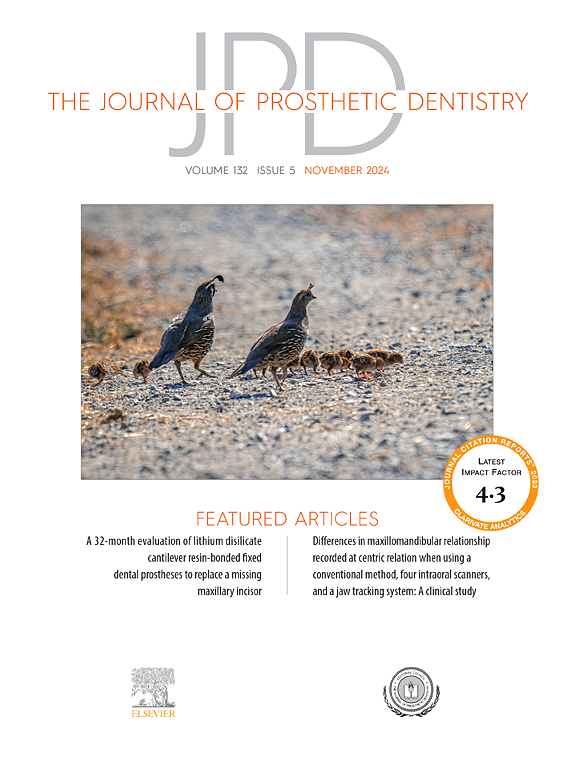Evaluating risk factors associated with poor removable prosthesis hygiene in community-dwelling elders: A cross-sectional study
IF 4.8
2区 医学
Q1 DENTISTRY, ORAL SURGERY & MEDICINE
引用次数: 0
Abstract
Statement of problem
Removable dental prosthesis cleanliness is multifactorial, and key clinical and nonclinical factors associated with prosthesis hygiene should be identified to inform practice, particularly given the dearth of studies relating specifically to prosthetic factors and prosthesis cleanliness.
Purpose
The purpose of this cross-sectional clinical study was to evaluate removable dental prosthesis cleanliness among community-dwelling elders by using a semi-automated planimetric assessment and to determine factors associated with removable prosthesis cleanliness.
Material and methods
The cross-sectional study was conducted among community-dwelling elders wearing removable prostheses. Digital images of plaque on removable prostheses were made after staining with a plaque-disclosing agent by using a single-lens reflex camera with a standardized arrangement. The area of plaque coverage was quantified by using a semi-automated planimetric assessment method. Participant profiles were recorded, including sociodemographic and prosthesis-related variables. Variations in removable prosthesis cleanliness were determined in bivariate and regression analyses with the forward Wald test (α=.05).
Results
A total of 97 community-dwelling elders attending a hospital dental clinic were recruited (41 men and 56 women). The mean percentage of prostheses covered with plaque was 24.8%, and 42 (43.3%) were deemed ‘unclean’ (plaque coverage>25%). Bivariate analyses identified numerous prosthesis-related factors associated with prosthesis cleanliness (P<.05) including prosthesis age, prosthesis material, prosthesis retention and stability, prosthesis fit, and presence of denture stomatitis. Logistic regression analysis indicated that prosthesis fit was the key factor associated with prosthesis cleanliness, accounting for sociodemographic and other prosthesis-related factors (P<.001). Prostheses that were classified as completely ill-fitting were 12 times more likely to be unclean (OR=12.03; 95% CI 3.33–43.41) than those in the well-fitting group.
Conclusions
Among a community-dwelling sample of older individuals attending a teaching hospital, approximately half had unclean prostheses as identified by the semi-automated planimetric method. Prosthesis fit was a key factor associated with prosthesis cleanliness. The findings have implications for maintaining removable prosthesis hygiene in the community.
评估与社区居住老年人活动义肢卫生不良相关的危险因素:一项横断面研究
问题陈述:可拆卸义齿清洁是多因素的,应确定与义齿卫生相关的关键临床和非临床因素,以告知实践,特别是考虑到缺乏专门与义齿因素和义齿清洁相关的研究。目的:本横断面临床研究的目的是通过半自动平面测量法评估社区居住老年人的可移动义齿清洁度,并确定与可移动义齿清洁度相关的因素。材料与方法采用横断面研究方法对佩戴活动义肢的社区老年人进行研究。采用标准排列的单镜头反相机,用牙菌斑揭露剂染色后,对可移动义齿上的牙菌斑进行数字成像。采用半自动平面测量法对斑块覆盖面积进行量化。记录参与者的资料,包括社会人口统计学和假体相关变量。采用正向Wald检验的双变量和回归分析确定可移动义肢清洁度的变化(α= 0.05)。结果共招募了97名在某医院牙科诊所就诊的社区老年人(男41名,女56名)。被菌斑覆盖的假体平均百分比为24.8%,42个(43.3%)被认为是“不清洁”(菌斑覆盖率为25%)。双变量分析确定了许多与假体清洁度相关的假体相关因素(P< 0.05),包括假体年龄、假体材料、假体固位和稳定性、假体契合度和义齿口炎的存在。Logistic回归分析显示,考虑到社会人口统计学和其他与义肢相关的因素,义肢契合度是影响义肢清洁度的关键因素(P<.001)。完全不拟合组的不洁可能性是拟合良好组的12倍(OR=12.03; 95% CI 3.33-43.41)。结论在一家教学医院的社区居住老年人样本中,通过半自动平面测量方法发现,大约一半的人假体不洁。假体配合度是影响假体清洁度的关键因素。该研究结果对维持社区可移动假体卫生具有重要意义。
本文章由计算机程序翻译,如有差异,请以英文原文为准。
求助全文
约1分钟内获得全文
求助全文
来源期刊

Journal of Prosthetic Dentistry
医学-牙科与口腔外科
CiteScore
7.00
自引率
13.00%
发文量
599
审稿时长
69 days
期刊介绍:
The Journal of Prosthetic Dentistry is the leading professional journal devoted exclusively to prosthetic and restorative dentistry. The Journal is the official publication for 24 leading U.S. international prosthodontic organizations. The monthly publication features timely, original peer-reviewed articles on the newest techniques, dental materials, and research findings. The Journal serves prosthodontists and dentists in advanced practice, and features color photos that illustrate many step-by-step procedures. The Journal of Prosthetic Dentistry is included in Index Medicus and CINAHL.
 求助内容:
求助内容: 应助结果提醒方式:
应助结果提醒方式:


